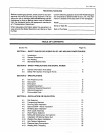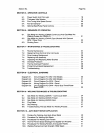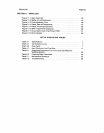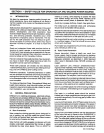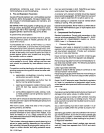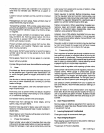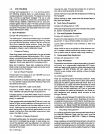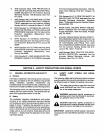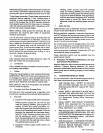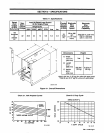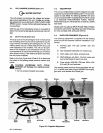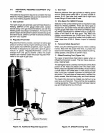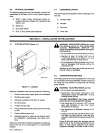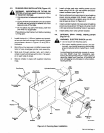
1-3.
ARC
WELDING
Comply
with
precautions
in
1-1, 1-2,
and
this
section.
Arc
Welding,
properly
done,
is
a
safe
process,
but
a
careless
operator
invites
trouble.
The
equipment
carries
high
currents
at
significant
voltages.
The
arc
is
very
bright
and
hot.
Sparks
fly,
fumes
rise,
ultraviolet
and
in
frared
energy
radiates,
weidments
are
hot,
and
com
pressed
gases
may
be
used.
The
wise
operator
avoids
unnecessary
risks
and
protects
himself
and
others
from
accidents.
Precautions
are
described
here
and
in
stan
dards
referenced
in
index.
A.
Burn
Protection
Comply
with
precautions
in
1-2.
The
welding
arc
is
intense
and
visibly
bright.
Its
radiation
can
damage
eyes,
penetrate
lightweight
clothing,
reflect
from
light-colored
surfaces,
and
burn
the
skin
and
eyes.
Skin
burns
resemble
acute
sunburn,
those
from
gas-
shielded
arcs
are
more
severe
and
painful.
DONT
GET
BURNED;
COMPLY
WITH
PRECAUTIONS.
1.
Protective
Clothing
Wear
long-sleeve
clothing
(particularly
for
gas-shielded
arc)
in
addition
to
gloves,
hat,
and
shoes
(1
-2A).
As
nec
essary,
use
additional
protective
clothing
such
as
leather
jacket
or
sleeves,
flame-proof
apron,
and
fire-resistant
leggings.
Avoid
outer
garments
of
untreated
cotton.
Bare
skin
protection.
Wear
dark,
substantial
clothing.
Button
collar
to
protect
chest
and
neck
and
button
pock
ets
to
prevent
entry
of
sparks.
2.
Eye
and
Head
Protection
Protect
eyes
from
exposure
to
arc.
NEVER
look
at
an
electric
arc
without
protection.
Welding
helmet
or
shield
containing
a
filter
plate
shade
no.
12
or
denser
must
be
used
when
welding.
Place
over
face
before
striking
arc.
Protect
filter
plate
with
a
clear
cover
plate.
Cracked
or
broken
helmet
or
shield
should
NOT
be
worn;
radiation
can
pass
through
to
cause
burns.
Cracked,
broken,
or
loose
filter
plates
must
be
replaced
IMMEDIATELY.
Replace
clear
cover
plate
when
broken,
pitted,
or
spattered.
Flash
goggles
with
side
shields
MUST
be
worn
under
the
helmet
to
give
some
protection
to
the
eyes
should
the
helmet
not
be
lowered
over
the
face
before
an
arc
is
struck.
Looking
at
an
arc
momentarily
with
unprotected
eyes
(particularly
a
high
intensity
gas-shielded
arc)
can
cause
a
retinal
burn
that
may
leave
a
permanent
dark
area
in
the
field
of
vision.
3.
Protection
of
Nearby
Personnel
Enclosed
welding
area.
For
production
welding,
a
sepa
rate
room
or
enclosed
bay
is
best.
In
open
areas,
sur
round
the
operation
with
low-reflective,
non-combusti
ble
screens
or
panels.
Allow
for
free
air
circulation,
par
ticularly
at
floor
level.
Viewing
the
weld.
Provide
face
shields
for
all
persons
who
will
be
looking
directly
at
the
weld.
Others
working
in
area.
See
that
all
persons
are
wearing
flash
goggles.
Before
starting
to
weld,
make
sure
that
screen
flaps
or
bay
doors
are
closed.
B.
Toxic
Fume
Prevention
Comply
with
precautions
in
1
-2B.
Generator
engine
exhaust
must
be
vented
to
the
outside
air.
Carbon
monoxide
can
kill.
C.
Fire
and
Explosion
Prevention
Comply
with
precautions
in
1
-2C.
Equipments
rated
capacity.
Do
not
overload
arc
welding
equipment.
It
may
overheat
cables
and
cause
a
fire.
Loose
cable
connections
may
overheat
or
flash
and
cause
a
fire.
Never
strike
an
arc
on
a
cylinder
or
other
pressure
ves
sel.
It
creates
a
brittle
area
that
can
cause
a
violent
rup
ture
or
lead
to
such
a
rupture
under
rough
handling.
D.
Compressed
Gas
Equipment
Comply
with
precautions
in
1
-2D.
E.
Shock
Prevention
Exposed
hot
conductors
or
other
bare
metal
in
the
weld
ing
circuit,
or
in
ungrounded,
electrically-HOT
equip
ment
can
fatally
shock
a
person
whose
body
becomes
a
conductor.
DO
NOT
STAND,
SIT,
LIE,
LEAN
ON,
OR
TOUCH
a
wet
surface
when
welding,
without
suitable
protection.
To
protect
against
shock:
Wear
dry
insulating
gloves
and
body
protection.
Keep
body
and
clothing
dry.
Never
work
in
damp
area
without
adequate
insulation
against
electrical
shock.
Stay
on
a
dry
duckboard,
or
rubber
mat
when
dampness
or
sweat
can
not
be
avoided.
Sweat,
sea
water,
or
moisture
be
tween
body
and
an
electrically
HOT
part
or
grounded
metal
reduces
the
electrical
resistance,
and
could
en
able
dangerous
and
possibly
lethal
currents
to
flow
through
the
body.
A
voltage
will
exist
between
the
electrode
and
any
con
ducting
object
in
the
work
circuit.
Examples
of
conduct
ing
objects
include,
but
are
not
limited
to,
buildings,
elec
trical
tools,
work
benches,
welding
power
source
cases,
workpieces,
etc.
Never
touch
the electrode
and
any
metal
object
unless
the
welding
power
source
is off.
1.
Grounding
the
Equipment
Arc
welding
equipment
must
be
grounded
according
to
the
National
Electrical
Code,
and
the
work
must
be
grounded
according
to
ANSI
Z49.1
Safety
In
Welding
And
Cutting.
When
installing,
connect
the
frames
of
each
unit
such
as
welding
power
source,
control,
worktable,
and
water
cir
culator
to
the
building
ground.
Conductors
must
be
ade
quate
to
carry
ground
currents
safely.
Equipment
made
OM-113
336
Page
4




